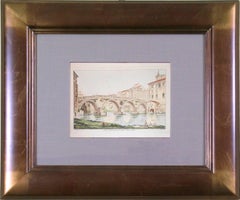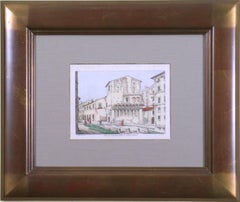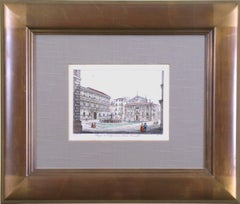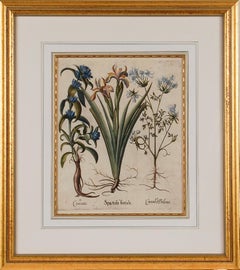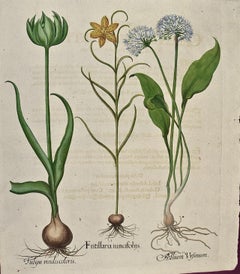Antonio Aquaroni Art
to
6
6
6
Overall Height
to
Overall Width
to
5
4
3
6
5
6
6,874
3,208
2,516
1,217
6
5
5
Artist: Antonio Aquaroni
Piazza de San Giacomo (Italy)
By Antonio Aquaroni
Located in Florham Park, NJ
ROMA (Italy)
A. Aquaroni.
Engraving. Modern Hand-Color.
Rome, Italy 1750.
Ever wonder what pre-dated the postcard? By the mid-eighteenth century, travel and exploration had be...
Category
1750s Academic Antonio Aquaroni Art
Materials
Watercolor, Engraving
Acquedotto de Sisto Quinta. (Italy)
By Antonio Aquaroni
Located in Florham Park, NJ
ROMA (Italy)
A. Aquaroni.
Engraving. Modern Hand-Color.
Rome, Italy 1750.
Ever wonder what pre-dated the postcard? By the mid-eighteenth century, travel and exploration had be...
Category
1750s Academic Antonio Aquaroni Art
Materials
Watercolor, Engraving
Ponte Gianniculense (Italy)
By Antonio Aquaroni
Located in Florham Park, NJ
ROMA (Italy)
A. Aquaroni.
Engraving. Modern Hand-Color.
Rome, 1750.
Ever wonder what pre-dated the postcard? By the mid-eighteenth century, travel and exploration had become a...
Category
1750s Academic Antonio Aquaroni Art
Materials
Watercolor, Engraving
Casa de Crescenzo (Italy)
By Antonio Aquaroni
Located in Florham Park, NJ
ROMA (Italy)
A. Aquaroni.
Engraving. Modern Hand-Color.
Rome, Italy 1750.
Ever wonder what pre-dated the postcard? By the mid-eighteenth century, travel and exploration had be...
Category
1750s Academic Antonio Aquaroni Art
Materials
Watercolor, Engraving
Tempio di Romolo, e Remo
By Antonio Aquaroni
Located in Florham Park, NJ
ROMA
A. Aquaroni.
Engraving. Modern Hand-Color.
Rome, 1750.
Ever wonder what pre-dated the postcard? By the mid-eighteenth century, travel and exploration had become a we...
Category
18th Century and Earlier Academic Antonio Aquaroni Art
Materials
Engraving, Watercolor
Piazza di San Giacomo (Italy)
By Antonio Aquaroni
Located in Florham Park, NJ
ROMA
A. Aquaroni.
Engraving. Modern Hand-Color.
Rome, Italy 1750.
Ever wonder what pre-dated the postcard? By the mid-eighteenth century, travel and exploration had become a w...
Category
1750s Other Art Style Antonio Aquaroni Art
Materials
Engraving
Related Items
Flowering Iris & Other Botanicals: Framed 17th C. Besler Hand-colored Engraving
Located in Alamo, CA
This is a hand-colored copper-plate engraving entitled "I. Spatula foetida - II. Caucalis Dodonei - III. Cruciata", depicting three flowering plants, including an Iris, from Basilius Besler's landmark work, Hortus Eystettensis (Garden at Eichstatt), first published in 1613 in Eichstatt, Germany near Nuremberg and later in 1640 and 1713.
This beautiful hand-colored botanical engraving is presented in a gold-colored wood frame with a French mat...
Category
Mid-17th Century Academic Antonio Aquaroni Art
Materials
Engraving
H 33.75 in W 30 in D 1.25 in
Besler Hand-colored Botanical Engraving of Flowering Tulip & Wild Garlic Plants
Located in Alamo, CA
This is a hand-colored copperplate engraving entitled "Tulipa viridiscoloris, Fritillaria iuncifolns, Allium Vrsinum" depicting flowering tulip, fritillary and wild garlic plants fro...
Category
Early 18th Century Academic Antonio Aquaroni Art
Materials
Engraving
View of Emden, Germany: A 16th Century Hand-colored Map by Braun & Hogenberg
By Franz Hogenberg
Located in Alamo, CA
This is a 16th century original hand-colored copperplate engraved map of a bird's-eye View of Embden, Germany entitled " Emuda, vulgo Embden vrbs Frisia orientalis primaria" by Georg Braun & Franz Hogenberg, in volume II of their famous city atlas "Civitates Orbis Terrarum", published in Cologne, Germany in 1575.
This is a beautifully colored and detailed map of Emden, a seaport in northwestern Germany, along the Ems River and perhaps portions of over Dollart Bay, near the border with the Netherland. The map depicts a bird's-eye view of the city from the southwest, as well as a view of the harbor and an extensive system of canals. Numerous ships of various sizes, as well as two rowboats containing numerous occupants are seen in the main waterway in the foreground and additional boats line two canals in the center of the city. Two men and two women are shown on a hill in the foreground on the right, dressed in the 16th century style of nobility. Two ornate crests are included in each corner. A title strap-work cartouche is in the upper center with the title in Latin. The crest on the right including Engelke up de Muer (The Little Angel on the Wall) was granted by Emperor Maximilian I in 1495.
This is an English translation of an excerpt of Braun's description of Embden: "In Emden, the capital of East Frisia, rich merchants live in very fine houses. The city has a broad and well-situated harbour, which in my opinion is unique in Holland. Frisia and the whole of the Netherlands, for the ships can anchor here right under the city walls. They have also extended the harbour as far as the New Town, so that up to 400 ships can now find shelter here when the sea is rough."
The emphasis on the harbor and waterways within the city highlights the importance of Emden's place as a seaport at this time. Embden developed from a Dutch/Flemish trading settlement in the 7th-8th centuries into a city as late as late 14th century. In 1494 it was granted staple rights, and in 1536 the harbour was extended. In the mid-16th century Emden's port was thought to have the most ships in Europe. Its population then was about 5,000, rising to 15,000 by the end of the 16th century. The Ems River flowed directly under the city walls, but its course was changed in the 17th century by the construction of a canal. Emden has canals within its city limits, a typical feature of Dutch towns, which also enabled the extension of the harbor. In 1744 Emden was annexed by Prussia and is now part of Germany. It was captured by French forces in 1757 during the Seven Years' War, but recaptured by Anglo-German forces in 1758. During the Napoleonic French era, Emden and the surrounding lands of East Frisia were part of the short-lived Kingdom of Holland.
References:Van der Krogt 4, 1230, State 2; Taschen, Braun and Hogenberg...
Category
16th Century Old Masters Antonio Aquaroni Art
Materials
Engraving
Mountebank - XXI Century, Contemporary Figurative DryPoint Etching Print
By Czeslaw Tumielewicz
Located in Warsaw, PL
Polish painter and graphic designer, Czeslaw Tumielewicz was born in 1942.
In 1968, he studied at the Architecture faculty of Gdank, before continuing his course at the Technical Un...
Category
2010s Contemporary Antonio Aquaroni Art
Materials
Paper, Etching, Drypoint
Flowering Feverfew Plants: A 17th C. Besler Hand-colored Botanical Engraving
Located in Alamo, CA
This is a hand-colored copper plate engraving entitled "Matricaria Flore Simplici, Matricaria Flore Pleno, depicting flowering Feverfew and Double-flowered Feverfew plants, from Basilius Besler's landmark work, Hortus Eystettensis (Garden at Eichstatt), first published in 1613 in Eichstatt, Germany near Nuremberg and later in 1640 and 1713. The feverfew plant is also known as featherfew, featherfoil, or bachelor’s buttons...
Category
1640s Academic Antonio Aquaroni Art
Materials
Engraving
Flowering Henbane : A Besler 18th Century Hand-colored Botanical Engraving
Located in Alamo, CA
This is a hand-colored copper plate engraving depicting flowering "Hyosciamus albus and Hyosciamus vulgaris" (Henbane) plants from Basilius Besler's landmark work, Hortus Eystettensi...
Category
Early 18th Century Academic Antonio Aquaroni Art
Materials
Engraving
Papaya and Moth Metamorphosis: 18th C. Hand-colored Engraving by Maria Merian
By Maria Sibylla Merian
Located in Alamo, CA
This exquisite hand-colored 18th century folio-sized engraving of a papaya plant and moth metamorphosis is plate 64 from Maria Sibylla Merian's publication '...
Category
Early 18th Century Academic Antonio Aquaroni Art
Materials
Engraving
View of Seravalle, Italy: A 16th Century Hand-colored Map by Braun & Hogenberg
By Franz Hogenberg
Located in Alamo, CA
This is an original 16th century copperplate originally hand-colored engraved map of View of Seravalle, Italy entitled "Seravallum Celeberrimum Marchiae Tarvisiniae in Agro Foro Juliensi Opp. - Seravalli, quam vides, Spectator, iconem, operi huic nostro suis sumptib. . . ." by Georg Braun & Franz Hogenberg, from their famous city atlas "Civitates Orbis Terrarum", published in Augsberg, Germany in 1575.
The map depicts a view of Seravalle, now Vittorio Veneto, in San Marino, Italy, north of Venice, in a topographically accurate bird's-eye view from the south. A water-filled moat is seen to the south of the city walls and farmland to the east. Two men are depicted standing on a hill in the lower right in conversation next to grain sacks and a grazing horse, while a younger man behind them to the right herds a mule carrying presumably pigs. A very colorful and ornate title cartouche is in the upper center and coat-of-arms are in the right and left upper corners. Serravalle lies in an idyllic setting in the foothills and surrounded by orchards. St Mary's Cathedral with its tall bell tower is prominent in the center of the town. The marketplace and town hall with a bell tower in the square are depicted. Houses and shops are around the main square. Serravalle's importance as an agricultural centre is emphasized by the figures in the foreground. In 1337 Serravalle was conquered by the Republic of Venice. In 1866 the town was united with neighbouring Ceneda to form the town of Vittorio Veneto.
The following is an English translation of an excerpt from the French description of the city on the back of the map: "Serravalle, a market town renowned for cloth, wine and grain, is in such a beautiful situation that the number of its inhabitants, attracted by the loveliness of the place, has grown so much at times that the wall encircling it has had to be enlarged for the third time. The city with the surrounding town once belonged to the Church in Ceneda as an imperial fief. It subsequently became the seat of the Da Camino family (a princely house that at that time was one of the five most noble in all Italy). Now the city is under the sway of the Venetians but is prudently governed by them. For they send only one city councillor with instructions to ensure that justice prevails and to collect duties. In all else, power lies in the hands of the noble families."
This is a translation of the Latin in the title cartouche on the front: "The picture of the town of Serravalle, which you see, viewer, has been contributed to our work entirely at his own expense by Minutius, son of Hieronymus Minutius, a noble gentleman and one renowned for the far-reaching competence of his jurisdiction. We saw him sojourning in Cologne, where he was on business for Gregory XIII; while our good wishes accompany him, we should also like to accompany him on his way with this remembrance, even though it might be against his will, so that even those who have not seen him may learn of his excellence. However, those who do not yet know him will also see his excellence if God the Almighthy does not summon erring souls too soon back to the eternal seat of the Blessed."
References: Van der Krogt 4, 4728, State 1; Taschen, Braun and Hogenberg, p.331; Fauser, #14960
This striking hand-colored city view is printed on laid, chain-linked paper with wide margins. The sheet measures 16" high by 21" wide. There is a central vertical fold as issued and French text on the verso, with Latin on the front. There is some discoloration in the upper and right margins which may represent some watercolor paint from the time of the original hand-coloring of the map. There is a small hole to the right of the upper portion of the vertical fold, which is only visible when held up to light and an area of reinforcement on the verso of the lower vertical fold. The map is otherwise in very good to excellent condition.
Braun and Hogenberg's 'The Civitates Orbis Terrarum' was the second atlas of maps ever published and the first atlas of cities and towns of the world. It is one of the most important books published in the 16th century. Most of the maps in the atlas were engraved by Franz Hogenberg and the text, with its descriptions of the history and additional factual information of the cities, was written by a team of writers and edited by Georg Braun. The work contained 546 bird-eye views and map views of cities and towns from all over the world. It gave graphic representation of the main features of the illustrated cities and towns, including the buildings and streets. Although the ordinary buildings are stylized, the principal buildings are reproduced from actual drawings created on location. The principal landmarks and streets can still be recognized today. In addition, the maps often include the heraldic arms of the city, the nature of the surrounding countryside, the important rivers, streams and harbors, even depicting stone bridges, wooden pontoons, flat-bottomed ferries, ships and working boats, wharves and jetties, as well as land-based activities, including horsemen, pedestrians, wagons, coaches, and palanquins. Small vignettes are often included which illustrate the trade, occupations and habits of the local inhabitants, such as agriculture, paper-making and textiles, as well as local forms of punishment, such as gibbets, wheels, floggings etc. Large figures dressed in their local costume are often presented out of proportion in the foreground. The aim of the authors was to give as much information as possible in a pleasing visual form. They succeeded in creating maps that were both informative and decorative works of art. The atlas is a wonderful glimpse of life in medieval Europe.
Georg Braun (1541-1622) was German Catholic...
Category
16th Century Old Masters Antonio Aquaroni Art
Materials
Engraving
A View of Scarborough, England: A Framed 19th C. Engraving After J. M. W. Turner
By J.M.W. Turner
Located in Alamo, CA
This beautiful 19th century framed engraving "Scarborough" by W. Chapman is based on an original painting by the renowned British artist J.M.W. Turner. It was published in London by ...
Category
Mid-19th Century Romantic Antonio Aquaroni Art
Materials
Engraving
H 18.25 in W 20.88 in D 1 in
Four 19th Century Hand Colored Engravings Depicting English Royal Residences
By Charles Wild
Located in Alamo, CA
Four hand colored etchings and aquatints depicting interiors within English royal residences, including "The Blue Velvet Room at Carlton House", "The Queen's Library at Frogmore", "T...
Category
1810s Academic Antonio Aquaroni Art
Materials
Engraving
H 15.5 in W 17.25 in D 0.88 in
Cactus & Rose of Jericho Plants: A Besler Hand-colored Botanical Engraving
Located in Alamo, CA
A hand-colored copper plate engraving depicting flowering "Melocactos" (Turk's Cap Cactus or Mother-in-law's Cushion), "Rosa Hiericontea aperta" (Rose of Jericho Unfolded), "Rosa Hie...
Category
Early 18th Century Academic Antonio Aquaroni Art
Materials
Engraving
Hand-colored 1834 Joseph Paxton Botanical Engraving of Yellow Trumpet Flowers
By Joseph Paxton
Located in Alamo, CA
A hand-colored engraving of yellow trumpet flowers from Sir Joseph Paxton's (1803-1865) "Magazine of Botany and Register of Flowering Plants", published in 1834. This engraving entit...
Category
Early 19th Century Academic Antonio Aquaroni Art
Materials
Engraving
H 19.25 in W 16.75 in D 0.63 in
Antonio Aquaroni art for sale on 1stDibs.
Find a wide variety of authentic Antonio Aquaroni art available for sale on 1stDibs. You can also browse by medium to find art by Antonio Aquaroni in engraving, paint, watercolor and more. Not every interior allows for large Antonio Aquaroni art, so small editions measuring 19 inches across are available. Customers who are interested in this artist might also find the work of Johan Christoph Volkhamer, John Wilkes, and William Wood (b.1774). Antonio Aquaroni art prices can differ depending upon medium, time period and other attributes. On 1stDibs, the price for these items starts at $395 and tops out at $395, while the average work can sell for $395.


